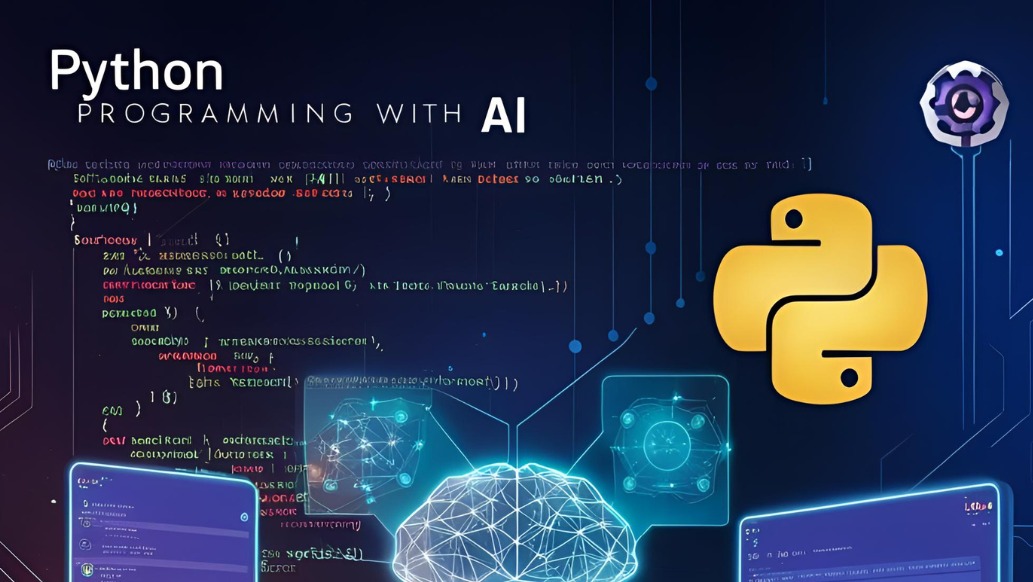
About Course
A Python with AI course typically extends beyond foundational machine learning by incorporating artificial intelligence concepts, algorithms, and practices that enable complex, autonomous systems. Here’s an outline that balances theory, practical tools, and hands-on AI applications:
What Will You Learn?
- Learning Python with a focus on artificial intelligence (AI) equips you to design intelligent systems, analyze complex data, and implement practical AI solutions. Here are key learning objectives:
- 1. Gain Proficiency in Python Programming
- • Master Python syntax, functions, and data structures essential for AI development.
- • Become proficient in libraries like NumPy, pandas, Matplotlib, and Seaborn for data manipulation and visualization.
- • Develop an understanding of object-oriented programming (OOP) to structure complex AI systems.
- 2. Understand Core AI and Machine Learning Concepts
- • Learn the distinctions and applications of supervised, unsupervised, reinforcement learning, and deep learning.
- • Grasp foundational AI concepts, including neural networks, decision trees, and clustering algorithms.
- • Understand AI ethics, fairness, and biases to develop responsible AI solutions.
- 3. Develop Data Preprocessing and Feature Engineering Skills
- • Learn to clean and preprocess data effectively for AI models (handling missing values, scaling, encoding).
- • Gain expertise in feature engineering techniques to enhance model performance.
- • Understand dimensionality reduction for simplifying data representation and improving computation efficiency.
- 4. Build and Evaluate Machine Learning Models
- • Implement core AI models (linear and logistic regression, SVM, k-means, decision trees) using Python.
- • Master model evaluation metrics (accuracy, precision, recall, F1 score, AUC-ROC) and validation techniques.
- • Gain experience in hyperparameter tuning (GridSearchCV, RandomizedSearchCV) to optimize model performance.
- 5. Develop Skills in Deep Learning and Neural Networks
- • Understand neural network architectures, backpropagation, and activation functions.
- • Use deep learning libraries (e.g., TensorFlow, Keras) to create and train neural networks.
- • Build Convolutional Neural Networks (CNNs) for image data and Recurrent Neural Networks (RNNs) for sequential data.
- 6. Gain Competence in Natural Language Processing (NLP)
- • Learn text preprocessing techniques like tokenization, stemming, and lemmatization.
- • Implement NLP models (e.g., sentiment analysis, text classification) using vectorization (TF-IDF, Word2Vec).
- • Explore transformer-based models (e.g., BERT, GPT) for advanced NLP tasks.
- 7. Explore Reinforcement Learning (RL)
- • Understand reinforcement learning concepts (states, actions, rewards) and basic RL algorithms (Q-learning, Deep Q-learning).
- • Work with environments (OpenAI Gym) to develop and train RL agents.
- • Learn about applications of RL, such as game AI, robotics, and dynamic decision-making.
- 8. Master Advanced AI Techniques
- • Implement Generative Adversarial Networks (GANs) for image generation and synthetic data creation.
- • Explore transfer learning to fine-tune pre-trained models for new tasks.
- • Study computer vision techniques (object detection, image segmentation) and their real-world applications.
- 9. Learn to Deploy and Scale AI Models
- • Gain skills in deploying AI models as web services using Flask or FastAPI.
- • Understand model versioning, monitoring, and scaling techniques.
- • Learn to deploy AI models on cloud platforms (e.g., AWS, GCP) for production use.
- 10. Promote Ethical and Interpretable AI
- • Identify potential biases in AI models and develop strategies to mitigate them.
- • Understand interpretability tools (SHAP, LIME) to explain model decisions to stakeholders.
- • Learn ethical considerations in AI, such as privacy, fairness, and transparency.
- 11. Gain Real-World Experience through AI Projects
- • Work on projects in diverse fields (e.g., healthcare, finance, robotics) to apply AI in real-world scenarios.
- • Develop problem-solving skills by building end-to-end AI solutions, from data processing to deployment.
- • Document and present AI projects to communicate findings effectively.
- These objectives cover both technical skills and ethical practices, empowering you to build effective and responsible AI solutions.
Course Content
Python and AI Foundations
-
Python Basics: Data types, loops, conditionals, functions, and classes
-
Data Structures: Lists, dictionaries, sets, tuples, and comprehensions
-
File Handling: Reading and writing files (CSV, JSON)
-
Core Libraries: Introduction to NumPy, pandas, Matplotlib, and Seaborn for data analysis and visualization
Introduction to Artificial Intelligence and Machine Learning
-
AI Overview: Key AI concepts, fields of AI (Narrow, General, Super AI), and real-world applications
-
Machine Learning Fundamentals: Supervised, unsupervised, and reinforcement learning
-
Ethics and Responsible AI: Bias, fairness, privacy, transparency in AI
Data Preprocessing and Feature Engineering
-
Data Cleaning: Handling missing values, duplicates, outliers, and imbalanced data
-
Feature Engineering: Encoding categorical variables, scaling, normalization, and feature selection
-
Dimensionality Reduction: PCA, LDA, and t-SNE for feature reduction and visualization
Supervised Learning Models
-
Regression: Linear regression, polynomial regression, regularization (Lasso, Ridge)
-
Classification: Logistic regression, k-Nearest Neighbors (KNN), Support Vector Machines (SVM), Decision Trees, and Random Forests
-
Model Evaluation: Accuracy, precision, recall, F1-score, ROC-AUC, and confusion matrix
-
Hyperparameter Tuning: GridSearchCV, RandomizedSearchCV for model optimization
Unsupervised Learning Models
-
Clustering: k-means, hierarchical clustering, DBSCAN
-
Association Rule Learning: Apriori and Eclat algorithms for market basket analysis
-
Anomaly Detection: Isolation Forests and One-Class SVMs for detecting outliers
Deep Learning Foundations
-
Neural Networks: Perceptrons, activation functions, loss functions, backpropagation
-
Deep Learning Libraries: Introduction to TensorFlow and Keras
-
CNNs (Convolutional Neural Networks): Concepts, filters, pooling, and building CNNs for image classification
-
RNNs (Recurrent Neural Networks): Sequential data, LSTM, GRU, applications in time series and NLP
Natural Language Processing (NLP)
-
Text Preprocessing: Tokenization, removing stop words, stemming, lemmatization
-
Vectorization: Bag of Words, TF-IDF, Word2Vec, GloVe embeddings
-
NLP Models: Building a sentiment analysis, text classification models
-
Advanced NLP with Transformers: BERT, GPT, fine-tuning transformer models for NLP tasks
Reinforcement Learning (RL)
-
Introduction to RL: Concepts like agents, states, actions, rewards
-
RL Algorithms: Q-Learning, Deep Q-Networks, policy gradients
-
Simulation Tools: Using OpenAI Gym for training RL agents
-
Applications: Building an agent for game simulations, robotics, or financial trading
Generative AI and GANs (Generative Adversarial Networks)
-
Generative Models: Autoencoders and Variational Autoencoders (VAEs)
-
GANs: Introduction to GANs, DCGANs for image generation, CycleGAN for image-to-image translation
-
Applications of Generative AI: Style transfer, synthetic data generation, image inpainting
Computer Vision
-
Image Processing Techniques: Resizing, normalization, image augmentation
-
Advanced CNN Architectures: Transfer learning with pre-trained models (ResNet, VGG, Inception)
-
Object Detection: YOLO, SSD for real-time object detection, Mask R-CNN for segmentation
-
Practical Applications: Image classification, face recognition, video processing
AI Model Deployment
-
API Development: Using Flask or FastAPI to deploy models as web services
-
Deployment Tools: Docker for containerization, deploying on cloud platforms (AWS, GCP, Azure)
-
Monitoring and Retraining: Model monitoring, handling data drift, retraining models in production
Explainable AI and Model Interpretability
-
Model Interpretability Tools: SHAP, LIME for explaining complex models
-
Bias and Fairness: Techniques to reduce and test model bias
-
Responsible AI: Ethical considerations, privacy, and transparency in AI solutions
Capstone Project
-
Project Development: Choose a domain (e.g., healthcare, finance, e-commerce) to apply AI
-
End-to-End Solution: Data collection, preprocessing, model training, evaluation, and deployment
-
Documentation and Presentation: Communicate findings, insights, and document the project comprehensively
